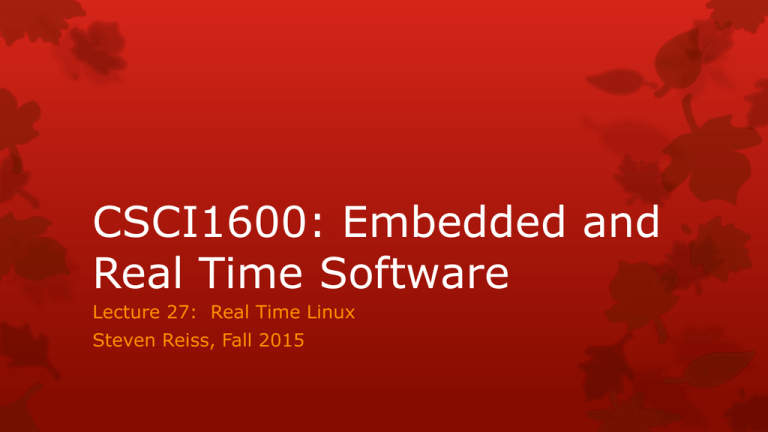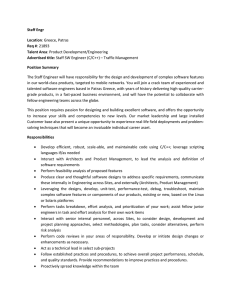CSCI1600: Embedded and Real Time Software Lecture 27: Real Time Linux
advertisement

CSCI1600: Embedded and Real Time Software Lecture 27: Real Time Linux Steven Reiss, Fall 2015 Conventional Operating Systems Memory model Independent address spaces Allocation and deallocation Stack management Device support Abstraction based on descriptors Clock and other basic devices built in High-level I/O support (e.g. networking) Thread / process model (with scheduling) IPC support (pipes, sockets, shared memory) Synchronization primitives Conventional OS Problems Size (for embedded) Micro-kernel based architectures help here Unpredictable (and poor) latency Slow interrupt handlers Unpreemptible kernel code Latency might be built into hardware System management interrupts on x86 DMA bus mastering; USB handling; VGA console; Page faults Unpredictable Scheduling Desktop/server heuristics Scheduling overhead grows with workload Poor support for precise timing Timing accuracy related to tick overhead Are the Problems Fixable? Want to retain the bulk of prior work Hundreds of device drivers Many abstractions make programming easier TCP/IP, File systems, IPC, Memory How can we do this? Two approaches to this are used Fixing the problems Sidestepping the problems RT-Linux Assume most of the program is non-real time There is a small hard (soft) real-time component Attempt to side step the problem Run the OS as a real time task Allow other RT tasks (outside the OS) Provide the benefits of an OS and still have a real time environment Except that Linux tasks are now sporadic Linux on a RTOS We’ve seen this before Scheduling sporadic tasks Bandwidth servers (Total and Constant) Group all the sporadic tasks together Provide a real-time task (with fixed bandwidth) This executes the various sporadic tasks Using their priorities This is basically RT-Linux Linux is “ported” to use RTOS primitives instead of hardware Like running on a virtual machine RT Linux RT-Linux Details RTLinux core Non-preemptible Hard real time scheduler Basic OS functionality Deterministic interrupt-latency ISRs run in core Others are transferred to Linux via a FIFO Primitive tasks Only statically allocated memory, no virtual memory, fixed priority Run as real time threads RT-Linux Details Real time tasks No address space protection Run with disabled interrupts FIFO (message queue) Connects real time tasks with LINUX Shared memory synchronization Non-real time tasks Run as Linux processes RT-Linux Pros and Cons Pros Hard real-time guarantees (low tens of microseconds) OS code is virtually unchanged Applies equally well to other OS’s Supports BSD as well as Linux Cons Real time task lose the convenience of a mature wellunderstood API Communication with Linux processes is ad-hoc Message queues – but user needs to define the messages Fixing the Problems Problems to tackle Scheduling, latency, timing Techniques Priority scheduling and priority inheritance Limit un-preemptible code Offer high-resolution timers Scheduling Real time schedulers are actually simpler Support for fixed (absolute) priority Ability to bind tasks to specific processors (cores) Create new classes of processes (RR, FIFO) Round robin runs for a fixed time slice FIFO is never guaranteed Enhance mutexes to support priority (PIP,PCP) Problem: scheduling latency Support fixed priorities But scheduling decisions might be deferred Interrupt handlers cannot be preempted Spin-locked code can not be preempted Minimizing Latency Simple Solution: Threaded interrupt handling Move interrupt handlers into kernel threads; true ISR is now very short Handling can be preempted Preemptible spin locks Turn spin locks into mutexes This almost works Timer interrupts need to be handled directly Individual handlers are still atomic Spinlocks not always equivalent to mutexes Programming devices, modifying page tables, in the scheduler Read-copy-update synchronization in Linux make non-preemption assumptions New type: raw_spinlock_t Other Improvements Dynamic tick Ask for timer IRQ as needed, not periodically High resolution timers O(1) scheduler Robust mutexes O(1) kernel memory allocation Ability to lock pages into memory (avoid page faults) Most problems can be minimized But retrofitting them to an OS make hard real time unlikely Solaris Attempt to fix the problems Starting with the initial OS design Not retrofitted Features of Solaris for real time Interrupts are handled by threads Kernel is fully preemptible and multithreaded Real time scheduling is supported Deterministic with real time priorities Fixed priority scheduling supported Solaris Real Time Threads Separate classes of threads Fixed-priority (non-varying) But lower priority than Operating System Real-Time (fixed priority with fixed quantum) Higher priority than operating system Real time threadss Lock their pages in memory Can call OS (but then run at lower priority) Solaris Features Priority inheriting synchronization primitives Processor sets The ability to isolate one or more CPUs for scheduling Ability to lock tasks to a particular core Full support for the Posix real time standard Real time threads High-precision timers and clocks Fast TCP/IP (zero copy) Memory locking Early binding of shared libraries Solaris Has been used as a hard real time environment But not as an embedded environment Too large Embedded Linux Linux is a common tool for embedded systems Linux itself is relatively small Linux is fairly modular It can run in 1M (or less) of memory Requirements on RT/Embedded Safety Requirements The car won’t crash Trains won’t crash Both traffic lights won’t be green at the same time You won’t blow a fuse The system won’t deadlock The heat and air conditioning won’t be on at the same time More Requirements: Timing Forms X will occur within k ms of event Y X will occur every 10 +/- 1 ms Examples The solenoid will trigger within 10 ms of the bumper being hit The switches will be sensed every 20 ms The heat will come on within 5 minutes of detecting the room is too cool More Requirements: Fairness Forms Eventually X will occur If X occurs, then eventually Y will occur X will occur infinitely often As long as Y is true, X will occur infinitely often Examples Eventually you will add K to the score when you hit Y As long as the heating system is on, the room will eventually be comfortable Requirements Are often mandatory (hard) Failure is not a viable option Car or plan crashes Broken devices Heart stops pumping Water is supplied unfiltered The nuclear plant does not shut down This is what hard real time means What Are Your Requirements? Problems How do you show the system is safe How do you get confidence in the system’s safety When can you reasonably deploy the system Can the system be used in a medical device Can peoples lives depend on the system Exercise Suppose you wanted to sell your tic-tac-toe box What would you want as requirements How would you check these? Take the ankle-mounted obstacle finder example What would be the requirements How would you check these? Helpful Techniques: SE Good requirements analysis Understanding all the possible problems and solutions Good specifications Accurate modeling Showing the models are correct Petri net and FSA validation Design for security Defensive coding Building monitors as part of the code Enter a safe state if the monitor detects anything wrong Enter a safe state if the monitor detects anything unusual Checking tools: lint, compiler, modeling analysis Homework Read chapter 13





